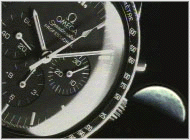
Speedmaster History
Speedmaster History |
|
A bit of general information
"Omega (literally "great o") : 24th ands last letter of the Greek alphabet, used to denote the long open "o" in ancient Greek. "I am the Alpha and Omega, the first and the last, the beginning and the end", quotes the Revelation of John. Omega is thus synonymous with accomplishment, completion, achievement, summum, maximum, perfection, excellence. The use of this name for the famous 19-line calibre introduced in 1894 and considered the "last word" in watchmaking technology at that time was the idea of Henry Rieckel, banker to the Brandt brothers." From "The History of a Great Brand" Omega brochure, march 1996.
Officially in 1848 by Louis Brandt. The name Omega appears
in 1894 on their famous 19-calibre watches and was the idea of Henry Rieckel, banker to
the Brandt brothers. Since then, little by little, the name Omega will be seen more and
more.
In the past, there were some wristwatches which didn’t fall in any of these categories but just were sold together with the other lines.The models changed drastically through the years, except for one. The Omega Speedmaster. Especially the first Seamasters and Constellations were quite look-a-likes. Later on, each line got it’s own identity. The Constellation as flag ship, a sportive dress watch, the DeVille, a classic dress watch, the Seamaster, a divers watch, the Dynamic, a "normal" sportive watch and the Speedmaster as a wristwatch with cronograph function. History of the Speedmaster
The first chronograph with the name "Speedmaster" appeared in 1957. And that is pretty much the same Speedmaster as we know it today. On first sight. Through the years, a lot of things were changed on this watch. For instance, the word "Professional" in 1966 when it was approved for NASA use (more on that later), in 1968 they (Omega) changed the movement from a calibre 321 (with "schaltrad") to a cheaper to produce, but more accurate calibre 861 (with shuttlesystem). Both movements were based on Lemania movements. Todays Speedmaster Professional watch still uses the 861 movement. Before 1957, there were also some chronographs (since 1942) using the 321 calibre but they had no "Speedmaster" written on the dial. The first Speedmaster (1957) looked like this :
This model, referenced as CK2915 was created
in 1957 and is nowadays hard to find. The watch has the 1/5th seconds, minute and hours
markings in white on a black dial. The counters are located on 3 o' clock, 6 o' clock and
9 o' clock. The bezel contains engraved tachymetre figures (not very clear on the photo
above). The movement used in this watch was a 27 CHRO
C12, better known as the Cal.321 (manual winding). In 1959 they produced a slightly modified Speedmaster, known as CK2998. The watch-case diameter expanded from 39mm to 40mm and they added a so called O-ring gasket around the push buttons.
Until 1966 there were no big changes on the watch (look for the "Differences through the years" in the menu for details). The NASA bought a Speedmaster along with some other chronograph watches to test it for use on their missions. Read all about it in the "Nasa tests" section of this website. After long and rigirous testing of the watch, the NASA concluded that the Omega Speedmaster was the most suitable watch for 'the' job. Omega decided to make this watch the Omega Speedmaster Professional. So the word "Professional" was added but it was still the same watch. The watch got also the 145.012 reference number. There are also watches from 1966 with 145.003, these are the non-Professionals from 1966. In 1968, Omega decided to replace the cal.321 movement by a more accurate movement which was also cheaper to produce, the cal. 861 which was also produced by Lemania. This movement is still being used in the current line of Omega Speedmaster Professionals. The movement was a bit more accurate, 21600A/h instead of 18000A/h. It also uses a shuttle cam instead of a "schaltrad" for the chronograph. Changes on the outside : white marked Omega-symbol instead of metal applied Omega-symbol and a flat dial.
In 1969, the first man walked on the moon.. Neil Armstrong. He didn't wear his Omega Speedmaster Professional. The clock inside the Lunar Module went broke, and he hung his Omega Speedmaster Professional in the Lunar Model as a clock-replacement. Buzz Aldrin, he did wear his Omega Speedmaster Professional. So his watch was the first watch worn on the moon. It was a Omega Speedmaster Professional with a cal. 321 movement (confirmed by Omega). A few months after the landing on the moon, Buzz's watch was stolen and never returned. In 1978, the watch was produced with an engraved caseback. "Fligt Qualified by NASA for all manned space missions - The first watch worn on the moon". Some casebacks have another text or logo engraved, I don't have an explanation at this time.
It is known that in 1969 some Speedmaster Professionals had already an engravement, but not the same as pictured above. |